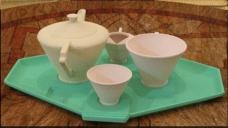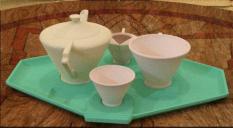What is the Iray Uber Shader?
I really should know this by now but to be honest...I don't. I was under the impression that this shader would change things that are optimized for 3DL into Iray. I attached 2 pictures, the first is the prop as it is in the scene. The 2nd is with the Iray Uber Shader applied. After looking at both, I obvoiusly felt the need to ask this question.


3DL.JPG
519 x 291 - 33K


Uber.JPG
525 x 289 - 34K



Comments
Not really, the shader merely applys the base, it helps but you will still need to alter the surface settings to get the best results, water and glass for example will need refraction so that needs to be set correctly among other things.
Your first scene autoconverted the items to Iray which from what I understand is the same as just appying the Iray shader base.
As Scorpio says, applying the iray Uber Base alone does nothing that DS wouldn't do at render time (except, I suppose, save a bit of time if you do it deliberately once rather than having DS do it automatically every time you render the scene). But having applied the shader you can then adjust the settings to enhance the look - for example you might use some TopCoat on your porcelain to make the glaze, perhaps with a less glossy setting on the base materials for the basic clay underneath. If it's real porcelain you should probably use the SSS settings to make it translucent.
I see. Thank you for clearing that up. It's not like flicking a switch, it's just like it says, a BASE.
Is there a tutorial or manual that lists what each adjuster does? The terms aren't self-explannatory. Instead of "topcoat" perhaps it should say "gloss coat" if in fact that is what that slider does. I assume these terms are standard in the industry and Daz /Iray is just using what is standard?
I'd love a manual with definition/descriptions of what the different sliders do in the surface tab! That would be very helpful. I'm with Deke, I don't know what half of them mean so I just try to leave those alone.
I'm not sure if this will help or hinder. I found it informative and useful as long as you read and try each section before proceeding to the next. There are some parts that are quite technical but aren't too hard to follow.
http://www.nvidia-arc.com/fileadmin/user_upload/PDF/arch_and_design.pdf
This may help
https://sickleyield.deviantart.com/journal/Iray-Surfaces-And-What-They-Mean-519346747
It takes a lot of digging, but here's the docs link I eventually found for the Iray parameters. Click on the three links under "Iray Uber Shader Modes" to see which parameters are active in each of the Iray modes. FWIW, right now I'm concentrating on figuring out the two PBR modes.
The only problem with these pages is that they don't really explain how to use the parameters — limits, effects, etc. — for anyone who doesn't know what the jargon means. I've got some use out of this link, but I know there's a lot I'm missing because I don't understand it.
As for "Top Coat", it's exactly what it says on the tin. Iray materials have three layers, Base, Metallic Flakes and Top Coat. Each of these layers have hidden parameters that only appear if you activate the layer. It gets complicated; look over the link and see if it makes sense to you.
Good stuff! Thank you all for putting that info out there.
Esha has a video tutorial on the Iray Uber Shader. It's a recording of a series of Webinars. It isn't cheap but I've got it and I found it very useful. This should be a link to it :
https://www.daz3d.com/the-complete-guide-to-creating-iray-shaders
I hope, this will help!
Iray Uber Shader: One more time!
Sorry for this basic questions :
-If I understand correctly what I read, when you have older stuff that you want to render in Iray, you need to apply first Iray Uber Shader so that you'll have access to to the various sliders that allow you to make changes. In fact, this shader change the structure of the surfaces (and the type of change you can make) to adapt it to Iray, is that correct?
-What happens if I make changes to a non-Iray surface without applying this shader? My changes are partially ignored when, during rendering, Daz changes the structure of the surface settings to fit Iray? They're "interpreted" and replaced by an equivalent Iray version?
-What happens if I apply an Iray shader (say, a water or metal shader) to a non Iray surface without appying firt Iray Uber shader? Obviously, some changes are made but...the changes aren't complete? They're ignored/modified during rendering? What exactly?
If surfaces are using the standard non-Iray shaders then DS will attempt to convert them at render time, so if you are not going to make chnages you don't need to do anything. Surfaces using custom shaders, however, will usually not be converted successfully and those do require prior attention (such as applying the Iray Uber Base, or one of the standard 3delight shaders)..
So, if I understand correctly, every time I want to make a change to a non Iray object (that I intend to render in Iray), be it by applying an Iray shader or making changes myself, I should first apply the Iray uber base or my changes won't be properly implemented when the image will be rendered, correct?
And I assume that by "standard non-Iray shaders", you mean those provided by Daz Studio, so for instance if I buy 3Dlight shaders from a PA in the shop, these aren't "standard"?
And what about those shaders that are now "Daz originals"? To give an example, are these shaders : https://www.daz3d.com/tarnished-and-polished-shaders ; "standard" shaders that Daz studio knows how to convert (even though the result of this conversion might not be similar to the original 3Dlight aspect) or "non standard" that it doesn't know how to convert and will give messed up results in Iray?
You would usually apply the Iray Uber Base to edit surface settings for use in Iray - though it will convert thes ettings for the standard 3delight shaders fairly well, mostly (by standard yes, I mean the ones that cme with DS - I'm not sure exactly which, but AoA SSS Shader and Daz Default Shader). Custom sahders would be new RSL code or Shader Mixer layouts, not just presets for one of the existing shaders; I think the set you linked to is presets, though I'm not certain.